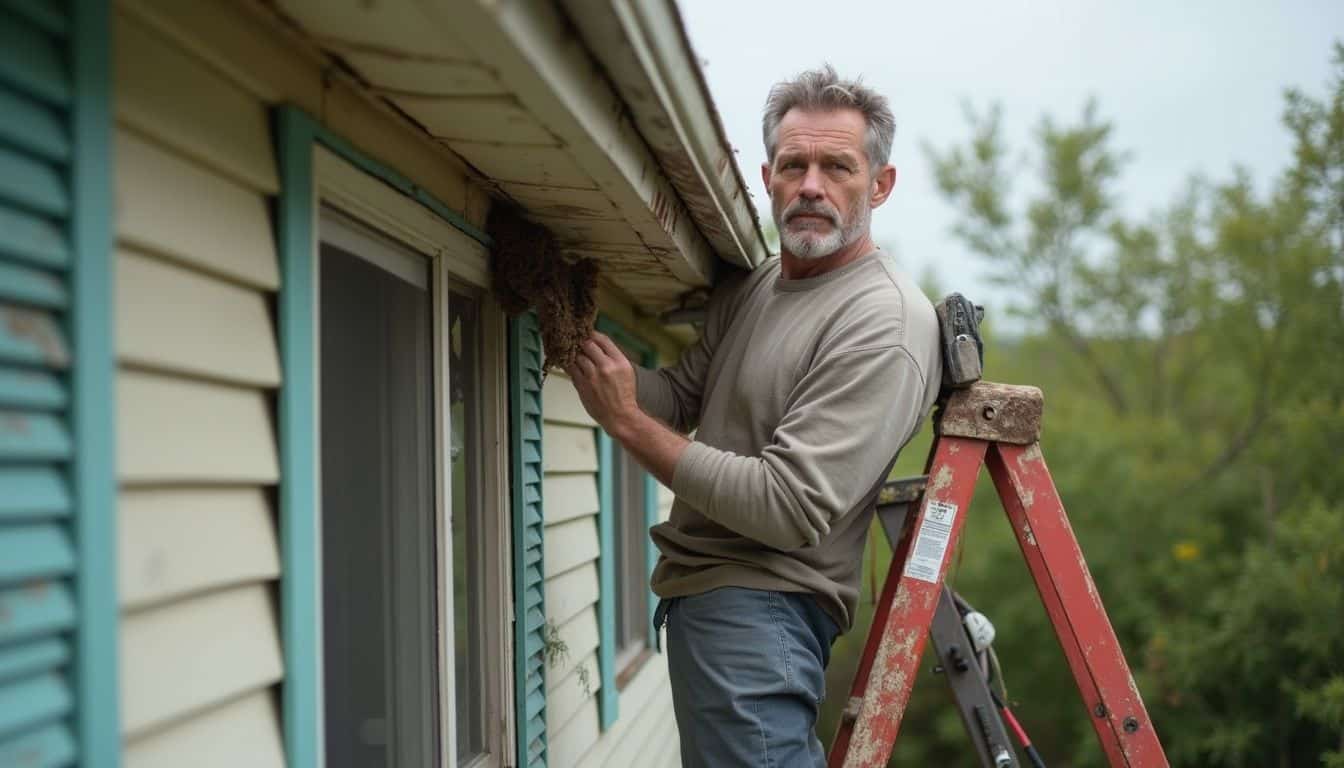Ever feel like the moment you fix one leaky faucet, a clogged gutter pops up to take its place? Keeping up with home maintenance can feel like a full-time job, but it’s the secret to protecting your property’s value and avoiding those shockingly expensive repair bills.
You don’t need to be a pro to handle it.
I’m going to walk you through six simple upkeep steps that make all the difference. Let’s tackle everything from routine inspections to keeping your heating and air conditioning happy, so you can stop worrying and start enjoying your home.
Key Takeaways
Inspect your property inside and out twice a year using a detailed checklist to spot leaks, cracks, rust, and damage early. Proactive checks and open communication with tenants can prevent major repair bills.
Clean your gutters and downspouts each spring and fall to prevent water damage. Clogged gutters are a top cause of flooded basements and foundation issues, which can lead to costly insurance claims.
Maintain your roof by checking for missing shingles and loose flashing from the ground with binoculars. Hiring a professional for steep roofs helps catch small problems before they become expensive leaks.
Flush your water heater every six to twelve months to remove sediment. This simple step, often recommended by plumbers, prevents higher energy costs and extends the appliance’s life.
Test smoke detectors monthly and replace their batteries annually. You should also clean dryer vents seasonally to prevent fire risks, as the U.S. Fire Administration reports that dryers cause thousands of house fires each year.
Table of Contents
How To Take Care Of Your Property With Regular Inspections

Walking through your home with a sharp eye and a flashlight is one of the most powerful things you can do. It’s all about catching those odd smells, soft spots on the floor, or tiny cracks before they grow.
A University of Connecticut study found that proactive home maintenance can slash overall repair costs. Think of it as a treasure hunt where the prize is saving money.
How do I walk through my property for an inspection?
Creating a system for your inspections protects your investment and turns a big chore into a manageable routine. You’ll spot problems long before they become disasters.
- Schedule it in advance. Give yourself (and any tenants or family members) a few days’ notice to make sure everything goes smoothly.
- Start outside. First impressions matter for curb appeal. Check the roof, gutters, siding, and walkways for any cracks or signs of wear.
- Use a detailed checklist. An app like HomeZada or a checklist from the International Association of Certified Home Inspectors (InterNACHI) can be a lifesaver. It ensures you don’t miss anything, from kitchen appliances to smoke alarms and insulation.
- Test all exterior lights. Check the LED bulbs around your doors and garage. It’s an easy fix that makes a big difference for safety.
- Focus on gutters. Clogged gutters are a primary cause of a wet basement or crawlspace, especially after a big spring storm.
- Look up at the roof. From the ground, look for missing shingles or soft spots. Catching a single loose shingle can save you thousands in water damage repairs during winter weather.
- Assess your landscaping. Are shrubs touching the siding? Are tree limbs getting too close to power lines? Your lawn care crew can help with pruning if it feels overwhelming.
- Check indoor air vents. Dust buildup can hurt your indoor air quality and make your HVAC system work harder, driving up energy bills.
- Inspect under every sink. A quick swipe with a paper towel can reveal small drips you might otherwise miss. These can quickly lead to costly plumbing system repairs.
- Check the water heater. Look for any signs of mold or rust. Flushing it once a year helps lower your heating bills and makes it last longer.
- Test your windows. Open them to check the locks and feel for drafts. According to the Department of Energy, drafty windows can significantly increase heating and cooling expenses.
- Confirm fire extinguishers are not expired. Test your smoke detectors by pressing the button, it’s a quick and important job.
- Test GFCI outlets. In your bathrooms and kitchen, press the “test” button on these outlets to ensure they’re working. This is a key step for meeting building codes.
- Scan appliance cords. Behind the washer and dryer, check for frayed cords or lint clogs. Vacuuming the dryer vent area is a 15-minute task that dramatically cuts fire hazards.
- Take notes. Keep a running list of needed maintenance. If you have tenants, discussing your findings openly keeps everyone on the same page.
What signs of damage or wear should I look for?
Knowing what to look for helps you catch problems early and avoid those expensive emergency repairs. Keep your eyes peeled for these common red flags around your property.
- Cracks in drywall or ceilings: These can signal foundation issues or hidden water leaks. Snap a photo to track any changes over time.
- Water stains: Dark patches or musty smells, especially in bathrooms, often point to a leak in the roof or plumbing system.
- Soft or sagging floors: Be extra careful with soft spots in kitchens or bathrooms, as they often warn of plumbing problems underneath.
- Rust on appliances: Check for orange streaks around your HVAC unit, water heater, or sump pumps, as this indicates a moisture issue.
- Peeling paint or bubbling siding: This is a classic sign that moisture is trapped underneath.
- Loose shingles: Use binoculars to spot shingles that are lifting or missing. This is an open invitation for rain to get in.
- Overflowing gutters: If water spills over the sides during a storm, it’s a sign they are clogged and need immediate cleaning.
- Cracked pathways: Mossy or cracked walkways can be a safety hazard. A power washer can help, but deep cracks may need patching.
- Signs of pests: Look for chewed leaves, dirt tunnels, or ant trails. Basic pest control can stop a small problem from becoming an infestation.
- Mildew on window sills: This often means the seals are failing, which leads to drafts and higher heating bills.
- Slow drains: If water lingers in your showers or sinks, it’s a clear sign of a hidden clog that a good drain cleaner might solve.
Maintain Your Home’s Exterior

Your house is constantly exposed to the elements. Simple chores like clearing out the gutters or touching up paint are your first line of defense against surprise repairs and help protect your investment.
How do I clean gutters and downspouts effectively?
Clean gutters are non-negotiable for preventing water damage and keeping your home safe. It’s a messy job, but doing it right keeps maintenance costs down.
Did you know? According to home service experts at Angi, the national average cost for professional gutter cleaning is between $150 and $225. Deciding whether to DIY or hire a pro can depend on your comfort with ladders and the height of your home.
- Gear up for safety. Always wear gloves and safety goggles. A sturdy ladder is a must for a one-story home, but call a professional for anything higher.
- Scoop out the gunk. Use a gutter scoop or a small garden trowel to remove leaves and debris. Tossing it onto a tarp below makes cleanup much easier.
- Use a leaf blower for help. If you have one, a leaf blower with a gutter attachment can make quick work of dry debris, especially on ranch-style homes.
- Rinse everything out. Use a garden hose with a high-pressure nozzle to flush the remaining dirt toward the downspouts. This ensures water can flow freely.
- Check for issues. As you rinse, look for any leaks or sagging sections. You can seal small leaks with waterproof caulk.
- Consider gutter guards. Products like GutterGlove or LeafFilter can significantly reduce how often you need to clean, especially if you have large trees nearby.
- Inspect the downspouts. If water isn’t flowing out freely at the bottom, there might be a clog. A plumber’s snake can often clear it out.
How can I inspect and maintain my roof?
Putting off roof maintenance can lead to some of the most expensive home repairs. Ensuring you have regular visits from a roof maintenance services company keeps your property in good condition for longer. A little attention each season is far better than an emergency call during a storm.
- Check it twice a year. Make roof inspections a part of your spring and fall routine.
- Use binoculars from the ground. This is the safest way to look for missing, cracked, or curling shingles.
- Look for interior clues. Water stains on your ceilings are a telltale sign of a potential roof leak.
- Sweep off debris. After storms, clear away any leaves or twigs. Debris traps moisture, which can lead to moss and rot.
- Hire a pro for a closer look. A roof maintenance services company can spot issues you might miss. A 2022 report from the National Association of Realtors found that a new roof can provide a 107% return on investment, making its care a top priority.
- Check attic ventilation. On a warm day, your attic should feel like it has good airflow. Poor ventilation can shorten the life of your shingles and increase cooling costs for your HVAC system.
- Trim nearby tree branches. Keep branches at least five feet away from your roof to prevent scratching and debris buildup.
- Keep gutters clean. Clogged gutters can cause water to back up under your shingles, leading to leaks.
- Scan the flashing. Look for any loose metal around chimneys, vents, and skylights, as these are common spots for water to sneak in.
What is the best way to wash siding and touch up exterior paint?
Your home’s siding takes a beating from sun and storms. A good cleaning and quick paint touch-ups keep it looking fresh and protected from damage.
- Choose a gentle “soft wash” method. This technique uses low water pressure combined with safe cleaners, like Krud Kutter House & Siding Cleaner, to avoid damage.
- Use a pressure washer on low. For stubborn dirt, a pressure washer set between 1,300-1,600 PSI is usually safe for vinyl siding. Use a much lower setting (500-600 PSI) for wood.
- Hand-wash tricky spots. Use a soft-bristled brush for corners and trim where grime collects.
- Stick to pH-neutral cleaners. Cleaners with a pH between 7 and 8 are best. Harsh chemicals can strip finishes.
- Tackle mold and algae immediately. Don’t let green gunk sit, as it can etch into the paint over time.
- Wash twice a year. A spring cleaning removes winter grime, and a fall wash preps your home for the colder months.
- Rinse completely. Any leftover soap residue can attract more dirt.
- Spot-check for damage. Look for any chips or cracks, especially after a storm. Small issues can become big problems if left alone.
- Get an exact paint match. For touch-ups, bring a small chip of your paint to a hardware store. They can scan it for a perfect match.
- Sand and prep the area. Lightly sand only the damaged spot before dabbing on fresh exterior paint. This helps the new paint adhere properly.
How do I fill driveway cracks and clean pathways?
Taking an afternoon to fill driveway cracks and clean your pathways is an easy win for boosting curb appeal and preventing bigger issues down the road.
- Inspect the entire driveway. Walk it slowly and measure any cracks so you know what kind of filler to buy.
- Clear out weeds and debris. Use a screwdriver or weeding tool to get all the grass and dirt out of the cracks.
- Scrub and sweep. Use a wire brush to clean the crack, then sweep it clean. A pressure washer works wonders on deep grime.
- Choose the right filler. For asphalt, use a water-based acrylic filler like Quikrete Concrete Crack Seal. For concrete, a patching compound is best.
- Apply carefully. Follow the product directions. The best time to apply is usually when the temperature is above 50°F.
- Seal the surface. After filling cracks in an asphalt driveway, applying a quality sealer provides a protective topcoat. Just be sure to let it dry completely.
- Wear protective gear. Gloves and eye protection are your friends here.
- Consider mudjacking for deep cracks. For large, sunken concrete slabs, mudjacking can be a cost-effective alternative to pouring new concrete.
Landscaping and Yard Maintenance

A well-kept yard does more than just look pretty. Thinning tree branches and shaping shrubs keeps your plants healthy and can even improve your home’s energy efficiency.
How should I trim trees and shrubs properly?
Proper pruning gives your yard a clean, tidy look and helps your trees and shrubs thrive. Using the right tools at the right time is key to preventing damage.
- Use sharp, quality tools. A good pair of hand pruners from a brand like Fiskars is perfect for thin branches. You’ll want loppers for thicker ones and a pruning saw for large limbs.
- Prune at the right time. For most deciduous trees, late winter or early spring is ideal. For flowering plants, trim them just after they finish blooming.
- Shape evergreens in early summer. They heal faster during their active growth period.
- Know your cuts. A “heading cut” (snipping just above a bud) encourages bushier growth. A “thinning cut” (removing a branch near the main stem) improves airflow and reduces disease risk.
- Remove dead branches immediately. Don’t wait to trim any dead, damaged, or diseased branches, as they can be a safety hazard.
- Help young trees grow strong. Trim any suckers at the base and any branches that cross or rub against each other.
- Step back and check your work. Pause every few minutes to look at the overall shape. It’s easy to get carried away and over-prune one side.
- Call a pro for big jobs. If you have branches near power lines or large limbs that are too high to reach safely, it’s always best to hire a professional arborist.
What are the best practices to maintain lawn and garden areas?
A beautiful lawn starts with a few good habits. My neighbor and I have a friendly competition every spring, and these are the tips we both swear by.
- Mow high and often. Many lawn care forums will tell you that the biggest mistake is cutting grass too short. Follow the “one-third rule,” never removing more than one-third of the blade’s height at once. This encourages deep, healthy roots. Check out the benefits of regular mowing to learn more.
- Water deeply, not daily. Give your lawn about 1 to 2 inches of water per week. Watering early in the morning is best, as it reduces evaporation and allows the grass to dry before nightfall. This reduces energy consumption if you have an irrigation system.
- Mulch your garden beds. A two-inch layer of mulch helps retain moisture, suppress weeds, and keeps your garden looking neat.
- Weed consistently. Pulling a few weeds every few days is much easier than tackling an overgrown garden. It’s easiest after a rain when the soil is soft.
- Prune perennials after they bloom. Cutting back spent flowers cleans up the plant and often encourages a second round of blooms.
- Rake leaves promptly in the fall. A thick layer of wet leaves can smother your grass and lead to disease.
Plumbing and Water Systems

A quick check for leaks under your sinks could save you a massive headache and a call to your insurance company later. These simple steps can keep your water flowing where it’s supposed to.
Let’s spot trouble before it soaks your day!
How do I inspect pipes and faucets for leaks?
Small drips can add up to big repair bills and wasted water. In fact, the EPA’s WaterSense program reports that the average household’s leaks can waste nearly 10,000 gallons of water a year.
- Use a flashlight. Shine it under all your sinks, behind toilets, and around any exposed pipes to look for moisture, rust, or water stains.
- Run the faucets. Turn on both the hot and cold water at each faucet and watch for a steady flow. Listen for any strange noises.
- Wiggle the handles. Gently move faucet handles as you turn them on and off. Leaks often start where parts move.
- Try the food coloring trick. Put a few drops of dark food coloring in your toilet tank. If the color appears in the bowl within 30 minutes without flushing, your flapper valve is leaking.
- Check appliance hoses. Every few months, inspect the hoses connected to your washing machine, dishwasher, and refrigerator for any bulges or drips.
- Look at your water meter. Turn off all water in your house and check the meter. If the dial is still moving, you likely have a hidden leak somewhere.
- Consider a smart leak detector. Devices like the Flo by Moen or Phyn Plus can monitor your water usage and automatically shut off the water if they detect a major leak, giving you incredible peace of mind.
Why and how should I flush out my water heater?
If you have hard water, sediment can build up in your water heater tank, forcing it to work harder and driving up your energy bills. Flushing it out is a simple chore that pays off.
According to the Department of Energy, flushing your water heater annually can improve its efficiency by 25-30% and significantly extend its lifespan.
- Turn off the power. For a gas heater, turn the dial to “pilot.” For an electric one, flip the breaker off at the panel.
- Attach a garden hose. Connect a standard garden hose to the drain valve at the bottom of the tank. Run the other end outside or into a bucket.
- Open the pressure relief valve. This valve is usually on top of the tank. Opening it allows air to enter so the water can drain smoothly.
- Open the drain valve. Let the water run until it is clear. The first few gallons may be rusty or gritty, which is completely normal.
- Refill the tank. Once the water runs clear, close the drain valve, disconnect the hose, and turn the cold water supply back on to refill the tank. Then, turn the power or gas back on.
- Check your manual for tankless heaters. Tankless water heaters need to be descaled, usually with a vinegar solution, which is a slightly different process.
How can I check for water damage or mold?
Water damage and mold can sneak up on you, often hiding behind walls or under floors. Catching the early signs is crucial to preventing a costly remediation project.
- Look for physical changes. Scan your walls, ceilings, and floors for any warping, sagging, or peeling paint.
- Trust your nose. A persistent musty odor, especially in basements, laundry areas, or closets, is a huge red flag for mold. Many people on Reddit have shared how a musty smell in a closet was their first clue.
- Search for visible signs. Look for fuzzy patches of white, black, or green mold under sinks and behind toilets. For small patches of surface mold, a product like Concrobium Mold Control can be effective.
- Feel for dampness. Press your hand against carpets and baseboards, especially after heavy rain. Any soft or squishy spots mean trouble.
- Use a moisture meter. If you’re suspicious, a moisture meter (available at stores like Home Depot for under $40) can detect dampness behind surfaces.
- Know the cost of waiting. According to HomeAdvisor, professional mold remediation can cost over $3,000 on average, making early detection incredibly valuable.
Interior Maintenance
Keeping your home safe and comfortable starts inside. A few quick checks on your smoke alarms and air filters can provide peace of mind and protect your family.
How do I test smoke detectors and fire extinguishers?
Fire safety is one of the easiest and most important parts of home maintenance. These quick steps can save lives.
- Test smoke alarms monthly. Press the test button on each detector. You should hear a loud beep. If not, it’s time for new batteries.
- Replace batteries annually. Even if they seem fine, swap out the batteries in all your smoke detectors once a year. A good reminder is to do it when you change your clocks for daylight saving time.
- Replace the entire unit every 10 years. The National Fire Protection Association (NFPA) recommends this because the sensors lose sensitivity over time.
- Consider a smart detector. A device like the Google Nest Protect can test itself automatically and send an alert to your phone if it detects smoke, even when you’re not home.
- Check your fire extinguisher gauge. Once a year, make sure the needle on the pressure gauge is in the green zone. Also, check the expiration date printed on the extinguisher.
When and how should I change HVAC filters?
Changing your HVAC filter is a five-minute job that cleans your air, improves your system’s efficiency, and lowers your energy bills. The U.S. Department of Energy says a clean filter can reduce your energy consumption by 5% to 15%.
- Check it monthly. A good rule of thumb is to change your air filters every one to three months. If you have pets or allergies, you should check them monthly.
- Turn off the system. Before you pull out the old filter, always turn off your HVAC system for safety.
- Note the filter size and arrow. The size will be printed on the side of the filter. There will also be an arrow indicating the direction of the airflow, so make sure you slide the new one in the same way.
- Choose the right MERV rating. A filter with a MERV rating of 8 is standard, but if you have allergies, upgrading to a MERV 11 or 13 will capture more airborne particles.
- Sign up for a subscription. A service like FilterEasy can automatically deliver new filters to your door, so you never forget.
How do I clean and inspect dryer vents?
This is a critical safety task. According to the U.S. Fire Administration, nearly 3,000 house fires are caused by dryers each year, and the leading cause is a failure to clean them.
- Unplug the dryer. Safety first! Also, turn off the gas supply if you have a gas dryer.
- Disconnect the vent pipe. Gently pull the dryer away from the wall and disconnect the vent from the back of the machine.
- Vacuum out the lint. Use your vacuum’s hose attachment to clean out the vent pipe and the hole in the wall.
- Use a vent cleaning brush. A long, flexible brush, like the Sealegend Dryer Vent Cleaner Kit, is designed to snake through the entire vent line to loosen stubborn lint.
- Clean the outside vent. Go outside and make sure the exterior vent flap opens and closes freely and is clear of any debris or nests.
- Reconnect and test. Put everything back together tightly. Run the dryer on an air-only cycle for a few minutes to make sure everything is working correctly.
- Clean the lint screen after every load. This is the easiest and most effective way to prevent buildup between deep cleanings.
How can I check seals around windows and doors?
Now that your vents are clear, let’s focus on stopping drafts. Checking the seals around your windows and doors is a simple way to save money and keep your home more comfortable.
- Do the hand test. On a windy day, run your hand along the edges of your windows and doors. If you feel a draft, you have a leak.
- Inspect the weatherstripping. Look for any pieces that are cracked, peeling, or missing. This is an easy and inexpensive fix.
- Check the caulk. Look for any gaps or cracks in the caulk around the exterior of your windows and doors. A fresh bead of GE Advanced Silicone sealant can make a big difference.
- Try the paper test. Close a door or window on a strip of paper. If you can pull it out easily without any drag, your seal isn’t tight enough.
- Look for condensation. Moisture between the panes of a double-pane window is a sign that the seal has failed and the window may need to be replaced.
- Install door sweeps. These are easy to attach to the bottom of your doors to stop drafts from sneaking in underneath. A sealed home is also great for keeping pests out, which is another smart part of your pest-free home upkeep routine.
Appliance Care
A little TLC for your major appliances can help them last longer and run more efficiently. Taking ten minutes to clean your fridge coils or run a cleaning cycle on your dishwasher really does pay off.
How do I clean refrigerator coils?
Dirty refrigerator coils can make your fridge work harder, waste energy, and even cause food to spoil faster. Cleaning them is a quick job that can have a big impact.
Appliance manufacturers like GE state that cleaning your refrigerator’s coils every six months can improve its energy efficiency by up to 30%.
- Unplug the refrigerator. This is the most important step for safety.
- Locate the coils. On most models, they are either on the back or at the bottom front, behind a kick plate.
- Vacuum the loose dust. Use your vacuum’s brush attachment to gently suck up the dust bunnies and pet hair.
- Use a coil brush. A long, thin coil brush can get into the tight spaces between the coils to remove stubborn grime.
- Wipe down the area. Use a microfiber cloth to clean up any remaining dust before you plug the fridge back in.
What steps should I take to maintain kitchen and laundry appliances?
Now that your fridge is breathing easier, let’s give some attention to your other hardworking appliances. These simple chores prevent breakdowns and keep them running smoothly.
- Run a cleaning cycle monthly. Use a product like Affresh for your washing machine or Glisten for your dishwasher to clear out soap scum and mineral buildup.
- Leave the washer door open. After doing laundry, leave the door of your front-loading washer ajar to let the drum dry out and prevent mildew.
- Replace washing machine hoses. To avoid a disastrous leak, replace the rubber inlet hoses on your washing machine every five years.
- Clean your garbage disposal. Freshen it up by running a few ice cubes and some citrus peels through it.
- Descale your coffee maker. Once a month, run a cycle with a solution of white vinegar and water to remove mineral buildup that can slow it down.
- Check your oven door seal. If the rubber or fiberglass gasket around your oven door is cracked or torn, it’s letting heat escape, making your oven less efficient.
- Keep your dishwasher filter clean. Most modern dishwashers have a filter at the bottom that catches food particles. Rinse it in the sink every few weeks to keep things draining properly.
How will home maintenance and property upkeep change in 2025?
In 2025, smart home systems will become your go-to partner for home maintenance. You’ll use mobile apps and devices like Google Nest or Alexa to track everything from potential water leaks to your home’s energy use.
These platforms will send you an alert before a pipe has a chance to freeze or your HVAC system acts up.
AI-powered solutions will help schedule routine tasks like cleaning and filter changes, making your to-do list feel much more manageable. You can also expect to see more eco-friendly and energy-efficient materials in everything from paint to appliances.
Remote diagnostic tools will even allow a professional to check on your systems without needing to visit. This proactive approach will help you fix small problems early, saving you time, money, and a whole lot of stress.
People Also Ask
What are the six critical upkeep steps for property care?
Start by checking your roof for damaged shingles and cleaning gutters to prevent water overflow. Inspect your plumbing for drips, since a small leak can waste over 3,000 gallons a year according to the EPA, and test your smoke alarms monthly. Keep landscaping trimmed to discourage pests like termites, and get your heating and cooling systems serviced each season to avoid surprise failures.
How often should I inspect my house’s roof and gutters?
You should look over your roof twice a year, usually in the spring and fall, checking for specific issues like cracked or curling shingles. Clean your gutters after the leaves have fallen or after major storms, as the Insurance Information Institute notes that water damage is one of the most common homeowners insurance claims.
Why is it important to maintain heating and cooling systems regularly?
Regular maintenance keeps your systems from breaking down during extreme weather and, according to the U.S. Department of Energy, can lower your heating and cooling costs by up to 30%. An annual service call to clean coils and check components helps improve air quality and prevent costly repairs.
Can skipping routine property care lead to bigger problems later?
Absolutely, as studies often show that every dollar spent on preventative maintenance can save you up to $100 in future repairs.
References
https://www.talentrpm.com/walk-through-inspections (2024-01-29)
https://www.doorloop.com/blog/rental-property-inspection (2024-08-16)
https://www.lowes.com/n/how-to/gutter-cleaning-and-repair
https://localroofs.com/blog/roof-maintenance-tips-for-homeowners/
https://www.owenscorning.com/en-us/roofing/blog/roof-maintenance
https://www.trottaspowerwashing.com/blog/clean-home-exteriors/ (2025-01-29)
https://homesmiles.com/a-guide-to-maintaining-your-propertys-exterior/
https://www.truevalue.com/diy-projects/maintenance-and-repair/repair-driveway-cracks-before-summer/
https://ryserslandscapesupply.com/pruning-guide-tree-and-shrub-maintenance/ (2023-04-13)
https://www.kingstownelawn.com/blog/all-inclusive-cheat-sheet-to-maintaining-landscape
https://cactusplumbingandair.com/plumbing-inspection-checklist/
https://hydromaxplumbing.com/blog/home-plumbing-inspection-homebuyer-tips/
https://askgem.com/blog/how-to-flush-water-heater/ (2025-02-23)
https://homesmiles.com/why-and-how-to-flush-your-hot-water-tank-a-complete-guide-for-homeowners/
https://evergreenairquality.com/blog/mold-testing-crucial-step-after-water-damage/
https://www.obfd3.com/smoke-alarms-and-how-to-maintain-them (2024-11-11)
https://homesmiles.com/a-step-by-step-guide-on-how-to-change-your-hvac-filter/
https://www.homedepot.com/c/ah/how-to-clean-a-dryer-vent/9ba683603be9fa5395fab90104093975
https://www.consumerreports.org/appliances/clothes-dryers/how-to-clean-your-dryer-vent-a5519869329/
https://www.prestigewindoor.com/7-ways-to-maintain-your-windows-and-doors/
https://www.lowes.com/n/how-to/windows-maintenance-checklist
https://thediyplaybook.com/how-to-clean-refrigerator-coils/ (2024-09-30)
https://www.affresh.com/knowledge-hub/appliance-maintenance-tips-to-last-longer/
https://agoodapplianceguy.com/5-maintenance-tips-for-your-kitchen-appliances/
https://www.h2horganizing.com/blog/2024/10/18/the-ultimate-guide-to-home-maintenance-in-2025 (2024-10-18)
